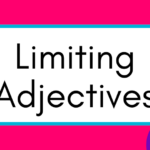Language is complex, filled with different elements that make it rich and interesting. One such element is the cumulative adjective, a grammatical tool that helps us describe things in more detail. In this article, we’ll take a closer look at what cumulative adjectives are, how to use them, and provide examples to make it all clear.
What are Cumulative Adjectives?
Cumulative adjectives, or string adjectives, are a series of adjectives used together to describe the same noun. They work as a team to give a more detailed picture of the noun. Unlike some other types of adjectives, cumulative adjectives usually have a specific order to make the description clear and logical.
For example, think of the phrase “a tall, dark, and handsome man.” Here, “tall,” “dark,” and “handsome” are cumulative adjectives working together to describe the man.
How to Use Cumulative Adjectives?
To use cumulative adjectives well, follow the order and use commas to separate them. Remember, not every category needs to be included, and some adjectives might fit into more than one category. They usually follow a specific order, moving from more general to more specific characteristics. The usual sequence is:
- Quantity or number
- Quality or opinion
- Size
- Age
- Shape
- Color
- Proper adjective (like nationality or material)
- Purpose or qualifier
For Example, in the phrase “three beautiful large old round red Spanish ceramic bowls,” each adjective adds a layer of detail following the prescribed order.
Examples of Cumulative Adjectives:
A Table of Cumulative Adjectives:
| Cumulative Adjective Sequence | Example |
| Quantity | Three |
| Quality | Beautiful |
| Size | Large |
| Age | Old |
| Shape | Round |
| Color | Red |
| Proper Adjective | Spanish |
| Purpose/Qualifier | Ceramic |
| Noun | Bowls |
Sentence Examples:
- The team celebrated their remarkable victory in the championship game.
- She bought five exquisite antique gold French jewelry pieces.
- We admired the tiny adorable puppy at the local animal rescue center.
Coordinate Adjectives vs. Cumulative Adjectives:
Coordinate Adjectives:
Coordinate adjectives are standalone adjectives that independently modify the same noun. Unlike cumulative adjectives, coordinate adjectives can be rearranged without changing the overall meaning of the sentence. They are typically separated by commas or the conjunction “and.”
Example:
- She wore a bright, colorful dress to the party.
- She wore a colorful, bright dress to the party.
In the above examples, the order of the coordinate adjectives can be switched without altering the meaning.
Cumulative Adjectives:
Cumulative adjectives, on the other hand, work as a team to modify the same noun, following a specific order to create a more detailed description. Unlike coordinate adjectives, changing the order of cumulative adjectives may result in confusion or alter the intended meaning.
Example:
- He lives in a small, quaint, historic house.
- He lives in a historic, small, quaint house.
In this case, changing the order of cumulative adjectives can affect the clarity and overall meaning of the description.
Table for better understanding:
| Criteria | Coordinate Adjectives | Cumulative Adjectives |
|---|---|---|
| Order | Can be rearranged without changing meaning. | Generally fixed to maintain clarity. |
| Separation | Separated by commas or “and.” | Often separated by commas; no conjunctions between them. |
| Flexibility | More flexible in terms of order. | Fixed order to provide a specific flow and enhance understanding. |
| Examples | Beautiful, cozy cabin by the lake. | Cozy, beautiful cabin by the lake. |
FAQs About Cumulative Adjectives
1: What are cumulative adjectives and how do you use them?
Cumulative adjectives, also known as string adjectives, are a series of adjectives employed together to describe a noun. They follow a specific order, from quantity to purpose, providing a detailed and logical description. Commas are used to separate them, ensuring clarity and coherence in expression. For example, in the phrase “a tall, dark, and handsome man,” these cumulative adjectives work collaboratively to vividly portray the man’s appearance.
2. How are cumulative adjectives different from other types of adjectives?
Well, unlike some other types, like coordinate adjectives that you can switch around without changing stuff, cumulative adjectives have a set order. They build on each other, going from general stuff to more specific details.
3. Do I have to follow a specific order when using cumulative adjectives?
Yes, there’s a suggested order to avoid confusion. Start with quantity or number, then quality or opinion, size, age, shape, color, proper adjective (like where it’s from or what it’s made of), and finally, purpose or qualifier.
4. How should I punctuate cumulative adjectives in a sentence?
Use commas between the adjectives. It helps keep things clear and easy to read.
5. Do I have to use all eight categories in a single description?
No, not at all. It depends on what you’re talking about. You might not need all eight for every description.
Conclusion:
In summary, cumulative adjectives help us describe things in a detailed way. Understanding what they are, how to use them, and seeing examples can improve our ability to use language more effectively. By following the order and using proper punctuation, we can use cumulative adjectives to make our writing more descriptive and clear.


